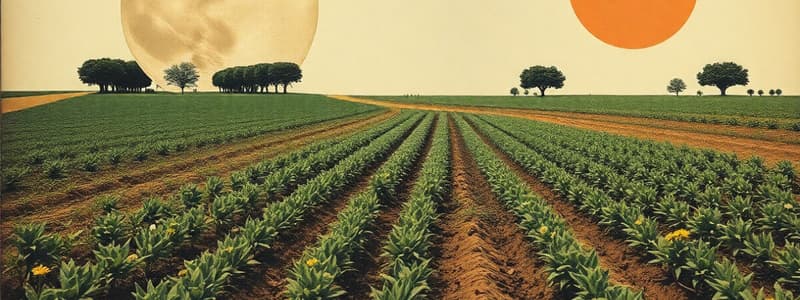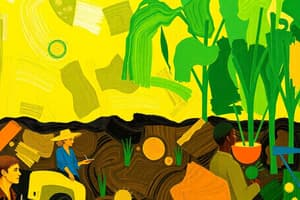Podcast
Questions and Answers
What is the primary focus of agronomy?
What is the primary focus of agronomy?
- Weather forecasting
- The study of insects
- The study of ancient civilizations
- Producing plants for food, fuel, feed, and fiber (correct)
Which of these is a core discipline within agronomy?
Which of these is a core discipline within agronomy?
- Soil science (correct)
- Astrophysics
- Linguistics
- Culinary arts
What is the main goal of plant breeding?
What is the main goal of plant breeding?
- Developing new tools for construction
- Studying animal behavior
- Developing new crop varieties with desirable traits (correct)
- Creating new types of plastic
What does plant physiology primarily study?
What does plant physiology primarily study?
What is weed science focused on?
What is weed science focused on?
What does the field of entomology study?
What does the field of entomology study?
What is the focus of plant pathology?
What is the focus of plant pathology?
What does water management in agronomy involve?
What does water management in agronomy involve?
What is the purpose of 'tillage' in crop production?
What is the purpose of 'tillage' in crop production?
What is the main objective of crop rotation?
What is the main objective of crop rotation?
What does 'irrigation' refer to in agriculture?
What does 'irrigation' refer to in agriculture?
What is the purpose of fertilization?
What is the purpose of fertilization?
What does pest management involve?
What does pest management involve?
What does soil testing determine?
What does soil testing determine?
What is the main goal of soil conservation practices?
What is the main goal of soil conservation practices?
What are macronutrients?
What are macronutrients?
What does weed identification help with?
What does weed identification help with?
What does 'harvesting' refer to in crop production?
What does 'harvesting' refer to in crop production?
What is precision agriculture about?
What is precision agriculture about?
What is a goal of sustainable agriculture?
What is a goal of sustainable agriculture?
Flashcards
What is Agronomy?
What is Agronomy?
The science and technology of producing and using plants for food, fuel, feed, and fiber.
What is Soil Science?
What is Soil Science?
Focuses on the characteristics and classification of soils, soil fertility, and nutrient management.
What is Plant Breeding?
What is Plant Breeding?
Developing new crop varieties with desirable traits, utilizing the principles of genetics.
What is Plant Physiology?
What is Plant Physiology?
Signup and view all the flashcards
What is Weed Science?
What is Weed Science?
Signup and view all the flashcards
What is Entomology?
What is Entomology?
Signup and view all the flashcards
What is Plant Pathology?
What is Plant Pathology?
Signup and view all the flashcards
What is Water Management?
What is Water Management?
Signup and view all the flashcards
What is Tillage?
What is Tillage?
Signup and view all the flashcards
What is Crop Rotation?
What is Crop Rotation?
Signup and view all the flashcards
What is Irrigation?
What is Irrigation?
Signup and view all the flashcards
What is Fertilization?
What is Fertilization?
Signup and view all the flashcards
What is Pest Management?
What is Pest Management?
Signup and view all the flashcards
What is Harvesting?
What is Harvesting?
Signup and view all the flashcards
What is Storage?
What is Storage?
Signup and view all the flashcards
What is Soil Testing?
What is Soil Testing?
Signup and view all the flashcards
What is Soil Conservation?
What is Soil Conservation?
Signup and view all the flashcards
What is Organic Matter Management?
What is Organic Matter Management?
Signup and view all the flashcards
What is Soil pH Adjustment?
What is Soil pH Adjustment?
Signup and view all the flashcards
What is Salinity Management?
What is Salinity Management?
Signup and view all the flashcards
Study Notes
- Agronomy is the science and technology of producing and using plants for food, fuel, feed, and fiber
- Agronomy encompasses work in the areas of plant genetics, plant physiology, meteorology, and soil science
Core Disciplines
- Soil science focuses on the characteristics and classification of soils, soil fertility, and nutrient management
- Plant breeding involves developing new crop varieties with desirable traits such as higher yield, disease resistance, and improved nutritional content by utilizing the principles of genetics.
- Plant physiology studies plant functions and processes at the cellular and molecular level, including photosynthesis, respiration, and nutrient uptake.
- Weed science is dedicated to understanding weed biology and ecology, as well as developing effective methods for weed control in agricultural systems
- Entomology studies insects and their interactions with crops, including beneficial insects and pests, with the goal of developing integrated pest management strategies
- Plant pathology involves the study of plant diseases, their causes, and their control, including identifying disease-resistant crop varieties and developing effective disease management practices
- Water management is concerned with the efficient use of water resources in crop production, including irrigation techniques, water conservation strategies, and drainage systems
Crop Production Practices
- Tillage is the preparation of land for planting, involving breaking up the soil to create a favorable seedbed
- Crop rotation is the practice of planting different crops in a planned sequence to improve soil health, manage pests, and increase yield
- Irrigation is the artificial application of water to crops to supplement rainfall and ensure adequate moisture for plant growth
- Fertilization involves the application of essential nutrients to the soil to support plant growth and maximize yield
- Pest management includes the use of various strategies to control weeds, insects, and diseases that can damage crops and reduce yield
- Harvesting is the process of gathering mature crops from the field
- Storage is the preservation of harvested crops to maintain their quality and prevent spoilage
Soil Management
- Soil testing is the analysis of soil samples to determine their nutrient content, pH, and other properties
- Soil conservation practices aim to prevent soil erosion and maintain soil fertility, including contour plowing, terracing, and cover cropping
- Organic matter management involves the use of compost, manure, and other organic materials to improve soil structure, fertility, and water-holding capacity
- Soil pH adjustment involves the use of lime or sulfur to raise or lower soil pH to the optimal range for crop growth
- Salinity management is important in arid and semi-arid regions to prevent the accumulation of salts in the soil, which can inhibit plant growth
Plant Nutrition
- Macronutrients are essential nutrients required by plants in large amounts, including nitrogen, phosphorus, and potassium
- Micronutrients are essential nutrients required by plants in small amounts, including iron, manganese, and zinc
- Nutrient deficiency symptoms can be used to diagnose nutrient imbalances in plants, allowing for corrective measures to be taken
- Fertilizer application methods include broadcasting, banding, and side-dressing, each with its own advantages and disadvantages
Weed Management
- Weed identification is the first step in developing an effective weed control strategy
- Cultural weed control practices include crop rotation, tillage, and cover cropping to suppress weed growth
- Chemical weed control involves the use of herbicides to kill or inhibit weed growth
- Biological weed control involves the use of living organisms, such as insects or pathogens, to control weeds
- Integrated weed management combines multiple weed control methods to achieve long-term weed control
Pest and Disease Management
- Pest and disease identification is crucial for selecting appropriate control measures
- Cultural pest and disease management practices include crop rotation, sanitation, and the use of resistant varieties
- Chemical pest and disease management involves the use of pesticides and fungicides to control pests and diseases
- Biological pest and disease management involves the use of beneficial organisms to control pests and diseases
- Integrated pest and disease management combines multiple control methods to minimize the use of pesticides and fungicides while maintaining crop health
Water Management
- Irrigation scheduling involves determining when and how much water to apply to crops based on their water needs and soil moisture levels
- Irrigation methods include surface irrigation, sprinkler irrigation, and drip irrigation, each with its own advantages and disadvantages
- Water conservation practices include reducing water waste, improving irrigation efficiency, and using drought-tolerant crop varieties
- Drainage systems are used to remove excess water from the soil, which can improve crop growth and reduce the risk of waterlogging
Agronomic practices for specific crops
- Cereal crops such as wheat, rice, and corn require high levels of nitrogen fertilizer for optimal yield
- Legume crops such as soybeans and alfalfa can fix atmospheric nitrogen in the soil, reducing the need for nitrogen fertilizer
- Oilseed crops such as sunflowers and canola require adequate phosphorus and potassium for optimal oil production
- Fiber crops such as cotton and flax require careful management of water and nutrients to produce high-quality fiber
- Forage crops such as hay and pasture require regular cutting or grazing to maintain their productivity and nutritional value
Advances in Agronomy
- Precision agriculture uses technology such as GPS, sensors, and drones to optimize crop production practices
- Biotechnology involves the use of genetic engineering to develop crops with desirable traits such as pest resistance and herbicide tolerance
- Sustainable agriculture aims to minimize the environmental impact of agriculture while maintaining or increasing crop yields
- Conservation tillage is a soil management practice that reduces soil erosion and improves soil health by leaving crop residues on the soil surface
Environmental Concerns
- Soil erosion is the loss of topsoil due to wind and water erosion, which can reduce soil fertility and productivity
- Water pollution can occur from the excessive use of fertilizers and pesticides, which can contaminate surface and groundwater
- Air pollution can occur from agricultural activities such as burning crop residues and applying fertilizers
- Greenhouse gas emissions from agriculture contribute to climate change
- Loss of biodiversity can occur from the conversion of natural habitats to agricultural land and the use of pesticides
Sustainable Agronomy
- Crop diversification is the practice of growing a variety of crops in a planned sequence to improve soil health, manage pests, and increase yield
- Reduced tillage is the practice of minimizing soil disturbance to reduce soil erosion and improve soil health
- Integrated pest management is the use of multiple pest control methods to minimize the use of pesticides and fungicides while maintaining crop health
- Nutrient management planning involves the use of soil testing and other tools to determine the appropriate rates and timing of fertilizer application
- Water conservation practices include reducing water waste, improving irrigation efficiency, and using drought-tolerant crop varieties
- Organic farming is a system of agriculture that avoids the use of synthetic fertilizers, pesticides, and genetically modified organisms
Studying That Suits You
Use AI to generate personalized quizzes and flashcards to suit your learning preferences.




